Courthouses in New South Wales
Courthouses in New South Wales were designed by the Colonial Architect, later known as the Government Architect.
History of New South Wales Local Courts
The first New South Welsh Charter of Justice of 2 April 1787 created the power to convene a criminal court. This was the Court of Criminal Jurisdiction. The first Charter of Justice also created a Court of Civil Jurisdiction to hear and determine in a summary way all pleas relating to real and personal property, debts, contracts, grant of probates and to administer intestate estates. Magistrates appointed in the early years of the colony were unpaid honorary appointments. The first paid magistrate was D'Arcy Wentworth appointed in 1810.[1]
Local Courts were known as Courts of Petty Sessions. Such courts had originated in England in the fourteenth century. Although during the early years of the colony references are made to Courts of Petty Session sittings by Magistrates, it was not until 1832 that Courts of Petty Sessions were formally established in New South Wales.[1]
The first Courts of Petty Sessions were proclaimed in the Government Gazette of 3 October 1832. The proclamations gave notice that Courts of Petty Sessions were to be held at the following locations: Sydney (Police Office and Hyde Park Barracks), Inverary, Parramatta, Bathurst, Windsor, Newcastle, Penrith, Paterson's Plains, Liverpool, Maitland, Campbelltown, Darlington, Wollongong, Invermein, Stonequarry Creek, Port Stephens, Bong Bong or Berrima, Port Macquarie, Goulburn Plains.[1]
More than three hundred courthouses have been built in New South Wales since settlement. The oldest existing Local Court in New South Wales is the Local Court at Windsor which was built in 1821.[1]
In 1985 the Local Courts Act abolished Courts of Petty Sessions by changing their name to Local Courts and appointments are now made under that Act. There are currently 160 Local Courts established throughout New South Wales and 130 Magistrates appointed.[1]
Current role
Local Courts in New South Wales have jurisdiction to deal with:[2][3]
- most criminal and summary prosecutions
- civil matters with a monetary value of up to $60,000
- committal hearings
- family law matters
- child care proceedings
- juvenile prosecutions and care matters
- coronial inquiries
- industrial matters
- mining matters
Local Courts also provide the following services:[2]
- Court Registries administer the sittings of the Local Court and provide registry services to the Court's clients.
- The Chamber Magistrate provides information about legal options and court proceedings, but cannot represent people appearing before the Court. In smaller Courts, the Chamber Magistrate service is often provided by the Clerk of the Court.
- Coroners hold inquests into deaths and inquiries into fires. Outside the metropolitan area, most Clerks of the Local Court are appointed as Coroners for the State. Within the metropolitan area, appointed coroners sit at the Coroner's Court of New South Wales in Glebe.
- Marriage Celebrant: Clerks of the Local Court at most country registries (and some larger metropolitan registries) are authorised to perform marriages.
- Licensing: Most major country and outer metropolitan registries process applications for and issue certain licences such as a liquor licence or commercial agents licence.
Courthouse buildings of New South Wales
Courthouses built from 1788–1862
| The oldest existing Local Court in New South Wales is the Local Court at Windsor which was built in 1821. The plan and specifications for the Windsor Courthouse were prepared by the Colonial architect, Francis Greenway. The courthouse was built for a sum of 1,800 pounds by William Cox, who also served there as a magistrate.[1] | |
| Courthouse at Berrima built between 1833 and 1838. It was designed by the Colonial Architect, Mortimer Lewis, in the Roman style. Four Doric columns support a Classical pediment.[4] The building is now stylistically classified as Georgian design. It is built of sandstone. There were a number of problems in building the courthouse; the first architect had resigned and three builders were involved.
The first quarter sessions were held at the courthouse in 1841. In 1843, the first trial by jury in the colony of New South Wales was held here. The assize courts were only continued for seven years. In 1850 the district court moved to Goulburn south of Berrima. Minor courts continued at Berrima until 1873. Notable trials were of John Lynch who was hung for the murder of at least nine people, and of Lucretia Dunkley and her lover Martin Beach who were both were hanged in 1843 for the murder of Dunkley’s husband. Dunkley was the only woman hanged at Berrima gaol. | |
| Darlinghurst Courthouse is an imposing sandstone building on Taylor Square. It was designed by Mortimer Lewis in 1844, and has a Greek Revival style facade. The central block is adapted from an 1823 design in Peter Nicholson's 'The New Practical Builder'.[5] | |
| Dungog courthouse was built in 1849 when the police barracks were converted, replacing a previous 1836 courthouse. It has been much added to since but remains the oldest Courthouse outside Sydney still in use. | |
| Paterson courthouse was completed in 1858, with extensive alterations made between 1861 and 1863. Mounted Police were stationed at Paterson from 1863 and lived in the barracks upstairs. Paterson was the centre for administration of justice in the Paterson Valley until the Court of Petty Sessions was abolished in 1967. The courthouse reopened in 1974 as a museum and still operates as such. | |
| Wollongong courthouse was designed by Alexander Dawson and built in 1858 and stands opposite the harbour. It was used as a courthouse until 1885 then it was used as the Customs House until 1903. It was the used as the Army Drill Hall until 1973 under the Commonwealth Government and was then used as the Naval Cadet Hall. In 1999 the Naval Cadets relocated and the building was restored. The old courthouse is now used as a community hall and hosts weddings, art shows and community events. | |
 |
Gundagai Courthouse, completed in 1859, was one of the first stone buildings to be erected after the Gundagai floods of 1852 and was the site for the trial of Captain Moonlite (the bushranger Andrew George Scott). The interior, originally red cedar, was destroyed by a fire in 1943 and rebuilt with mountain ash. The monument in front of the building is a Boer War memorial.[6] |
 |
Albury completed 1860. This courthouse was designed by the Colonial Architect Alexander Dawson in the palladian style. It was built out of local grey granite by Thomas Allen of Albury. In the press gallery there has been a tradition of journalists to carve their names. The first Clerk of Petty Sessions was John Roper, who had been a member of Leichhardt's 1844 expedition.[7] |
Courthouses built from 1862–1890
During the period that James Barnet was the Colonial Architect, his office was responsible for designing and building 130 courthouses across New South Wales. Some of these replaced existing courthouses where it was deemed the building had been outgrown.
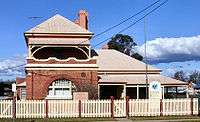 |
Holbrook completed in 1873. |
| Glen Innes Courthouse was built in 1873. | |
 |
Gundaroo Courthouse in Cork Street was built in 1875. A solid high-ceilinged structure, it was in use until 1934. In 1940, it was sold to the Anglican Church and became St Mark's Church in 1941. |
 |
Tumut Courthouse was completed in 1878 and the Stables in 1879. The adjacent Police Station had been completed in 1874. The Courthouse and Police Station are characterised by a hip roof and timber verandah posts.[8] |
| Gunning was completed in 1879. It was built onto the lock-up keeper's residence, which had been erected seven years earlier. It is a painted brick building with a hipped roof, clad in corrugated iron; the chimneys are topped by chimney pots. The front verandah has plain timber posts. The original cedar joinery on the inside of the building is intact. The double-height courtroom is flanked on either side by a single storey office wing (police station and office of the clerk of petty sessions).[9] | |
 |
Cowra - a Federation-style brick building with unusual gable ends. It is a symmetrical building with a distinctive double-height court room and Roman arches. It was completed in 1879.[10] |
 |
Forbes - a Classical Revival courthouse completed in 1880.[11] |
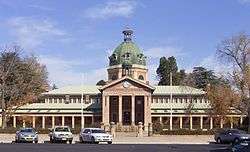 |
Bathurst Courthouse was completed in 1880. It is in the Neo-Classical style with an octagonal Renaissance dome. The wings, built as the postal and telegraph offices, were opened in 1877. The entire structure is 81 metres long and 45 metres wide. The west wing is now occupied by the Central Western Music Centre. The east wing is now the Historical Society Museum.[12] |
| A court of petty sessions was first established at Yass in 1836. The present courthouse was opened in 1880.[13] | |
 |
Taree Courthouse built in 1882. |
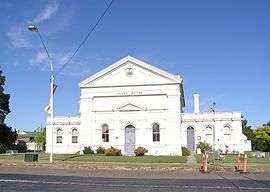 |
Boorowa completed 1884. It is a symmetrical building with a distinctive double-height court room and Roman arches.[14] |
| Inverell Courthouse was completed in 1886. | |
| Young Courthouse completed in 1886. It is in the High Victorian Classical style. The building is now used as a school assembly hall.[15] | |
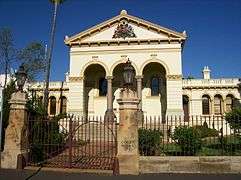 |
Dubbo Courthouse completed in 1887.[16] |
| Goulburn opened 1887. Italianate style, designed by the Colonial Architect James Barnet. | |
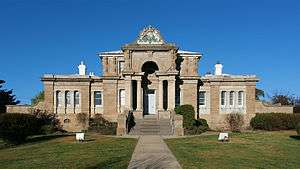 |
Cooma Courthouse completed in 1889. It has shuttered French windows and a front verandah.[17] |
| The first Kiandra courthouse was built in 1860 as part of the Police Commissioner's Camp. By the 1870s the building was being used as a barn. The second courthouse, which also served as the local lock-up and the police headquarters, was completed in 1890 and built from local basalt.[18] | |
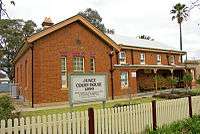 |
Junee Courthouse was designed by James Barnett (Government Architect) and was built in 1890. |
Courthouses built from 1890–present
| Braidwood built 1900, a Federation single-storey brick building, characterised by four Doric columns. The first courthouse in Braidwood had been built in 1837 by Dr Wilson.[19] | |
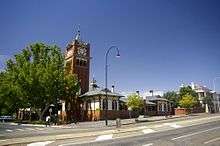 |
Wagga Wagga built in 1900, an Edwardian complex with massive square clock tower, belltower, cupolas, decorative iron work and cedar joinery and fittings. A police building and court premises were established in Wagga Wagga 1847.[20][21] |
 |
Condobolin built 1902. |
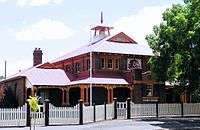 |
Temora built 1902. |
 |
Batemans Bay built 1905. The first Batemans Bay Courthouse and Police Residence was opened in 1885 opposite the waterfront in Clyde Street. The building was gutted by fire in October 1903. The second Courthouse was built on the corner of Orient and Church Streets (now Beach Road), where the current police station now stands. It now houses the Old Courthouse Museum. It was constructed of hardwood weatherboard and roofed with galvanised iron. Local cedar was used for the door frames and mantelpieces. Built at a cost of £930 it was opened on 14 October 1905. |
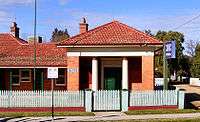 |
Culcairn built 1926. The establishment of a police presence in Culcairn was announced in the Wagga Wagga Advertiser on 17 January 1891. The police rented premises until a combined police station/courthouse and residence was built. |
| Leeton Courthouse built in 1943. | |
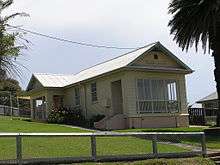 |
Narooma courthouse was criticised as being the "smallest in the country" in 2004. At that time 11 Indigenous Australians were on trial over a claim on fishing rights based on cultural and religious practices. The case was being heard over several weeks and it was reported that "There is no room for the men to sit in court when researchers and members of the public are present. Apart from a small wind exposed verandah there is no other shelter. There are no interviewing facilities for their lawyers who are crammed into a room which can only be described as a dog box."[22] The court moved from Eurobodalla to Narooma in 1895.[23] |
References
- 1 2 3 4 5 6 "History of Local Courts in New South Wales". Local Courts in New South Wales. www.lawlink.nsw.gov.au. 2005. Retrieved 2006-02-12. Archived May 26, 2007, at the Wayback Machine.
- 1 2 Ian R. Hunter (2003). "New South Wales Local Courts". The Thin Blue Line. www.policensw.com - Unofficial NSW Police Web site. Archived from the original on 2006-03-17. Retrieved 2006-02-12.
- ↑ "Local Courts of New South Wales". www.lawlink.nsw.gov.au. 2006. Retrieved 2006-02-12.
- ↑ Robert Irving (consultant architectural historian), ed. (1998). Reader’s Digest book of Historic Australian Towns (2nd ed.). Surry Hills, NSW, Australia: Reader’s Digest (Australia). pp. 56, 58. ISBN 0-86449-271-5.
- ↑ Apperly, Richard; Irving, Robert; Reynolds, Peter (1989). A Pictorial Guide to Identifying Australian Architecture: Styles and Terms from 1788 to the Present. Angus & Robertson, Sydney. ISBN 0-207-18562-X.
- ↑ "Gundagai". Sydney Morning Herald Travel. Fairfax Digital. 2004-02-08. Retrieved 2006-08-21.
- ↑ "Albury Heritage Trail". Albury City (www.alburycity.nsw.gov.au). 2005. Archived from the original on 2006-08-19. Retrieved 2006-02-13.
- ↑ "Tumut". Fairfax Walkabout Australian Travel Guide. Fairfax Digital. Archived from the original on 2006-05-22. Retrieved 2006-02-22.
- ↑ Alby Schulz (2004). "Gunning conservation project to receive almost $40,000". Media releases. Alby Schulz MP, Federal Member for Hume. Retrieved 2006-02-22.
- ↑ "Cowra". Sydney Morning Herald Travel. Fairfax Digital. 2004-02-08. Retrieved 2006-02-22.
- ↑ "Forbes". Sydney Morning Herald Travel. Fairfax Digital. 2004. Retrieved 2006-02-22.
- ↑ "Bathurst". Sydney Morning Herald Travel. Fairfax Digital. 2004. Retrieved 2006-06-19.
- ↑ "Yass, New South Wales". Australian Places. Monash University. 1997. Retrieved 2006-02-22. Archived June 17, 2005, at the Wayback Machine.
- ↑ "Boorowa". Sydney Morning Herald Travel. Fairfax Digital. 2004-02-08. Retrieved 2006-02-22.
- ↑ "Young". Sydney Morning Herald Travel. Fairfax Digital. 2004-02-08. Retrieved 2006-02-22.
- ↑ "History of Old Dubbo Gaol". Old Dubbo Gaol. Old Dubbo Gaol. Archived from the original on 2008-07-18. Retrieved 2008-06-26.
- ↑ "Cooma". Sydney Morning Herald Travel. Fairfax Digital. 2004. Retrieved 2006-02-22.
- ↑ "Kiandra". Sydney Morning Herald Travel. Fairfax Digital. 2004-02-08. Retrieved 2006-02-22.
- ↑ "Braidwood". Sydney Morning Herald Travel. Fairfax Digital. 2004-02-08. Retrieved 2006-02-22.
- ↑ "Wagga Wagga". Sydney Morning Herald Travel. Fairfax Digital. 2004-02-08. Retrieved 2006-08-04.
- ↑ "Wagga Wagga Courthouse". Aussie Heritage. Archived from the original on 2008-07-30. Retrieved 2008-06-16.
- ↑ "Narooma Court conditions slammed". Narooma News. 2004. Archived from the original on 2007-03-10. Retrieved 2006-02-22.
- ↑ "Narooma". Sydney Morning Herald Travel. Fairfax Digital. 2004-02-08. Retrieved 2006-02-22.
External links
![]() Media related to Court houses in New South Wales at Wikimedia Commons
Media related to Court houses in New South Wales at Wikimedia Commons